 |
|||||||||||
|
|
Banding Data
Location Code: OH-29
Click here to view written description.
|
||||||||||
| Description |
Ohio Rare Bird Report Species: Rufous Hummingbird (Selasphorus rufus), immature male Date & Time: October 29, 2007. First observed by homeowner on October 25, 2007 and last observed on January 11, 2008. I arrived around 9:30 a.m. and within 5 minutes the bird made an appearance. I then set up my trap at 9:40 a.m. and caught the bird at 9:43 a.m. The bird was banded and released at 10:04 a.m. under Federal permit No. 23156, and Ohio Wild Animal Permit 240. Location: At the home of Linda Houshower in Bluffton, Allen Co. Observer (s): Allen Chartier. Equipment: Photographed in-hand with digital camera. All measurements were made using digital calipers. Bill corrugations were determined by viewing through a 10x loupe, as they are impossible to accurately determine any other way. Viewing conditions: The sky was clear and the light was good. The bird was banded and weighed indoors and photographed outdoors. Description: When the bird first made an appearance at the feeder, it was apparent that it was a Rufous or Allenís Hummingbird, based on peach-rufous on the flanks, and a rufous tinge on the upperparts, including the upper tail coverts, indicating it was an immature male. This observation was made with 10x Swarovski EL binoculars from a distance of about 20-feet. The bird was then captured for banding, and it was aged, sexed, and identified in that order. The proper use of Stiles (1972) for banders requires that an individual Rufous/Allenís Hummingbird in-hand be correctly aged and sexed before a species determination can be made (B. Sargent and N. Newfield, pers. comm.). Age: The bird was aged as hatch-year (immature) based on the presence of shallow groovings or corrugations on about 60% of the upper mandible. This is universally recognized as the most reliable method for age determination in hummingbirds (Ortiz-Crespo, 1972). Sex: The central rectrix (r1) was extensively rufous-based, with rufous visible past the green upper tail coverts. This suggests that this bird was a male according to Figure 2 in Stiles (1972). The wing measurement of 42.36 mm was smaller than immature female Rufous given in Stiles, but within the range of immature females of both subspecies of Allenís. So wing length also supported that this bird was a male, provided it is a Rufous (see more below). The pattern of iridescent gorget feathers on the throat can sometimes be helpful in determining the sex of Selasphorus hummingbirds. This bird had 10 scattered around various areas of throat (see photos) including the outer edge. This pattern occurs most often in immature males, though the number of iridescent feathers varies considerably number alone is not particularly useful for supporting an age determination. Often, the iridescent throat feathers on females will be iridescent only on the outer fringes (upon examination with magnification), while those of males will be entirely iridescent from base to tip. This birdís iridescent gorget feathers were iridescent from base to tip. The bill measurement (exposed culmen) can sometimes be helpful for determining sex, but this birdís culmen of 18.01 mm was inconclusive as it overlapped several age and sex classes of both species, and is actually longer than that given for immature male Rufous (14.9-17.3mm). This may be due to the birdís body feather molt, which can sometimes shift the appearance of where the "insertion point" is at the base of the maxilla. Species: Given that the bird was a hatch-year (immature) male, using Stiles we can determine whether this bird was a Rufous or Allenís Hummingbird using several additional measurements and observations. The presence of notching and/or emargination on the second rectrix from the center (r2) is one feature that can often be observed in the field to confirm Rufous. This individual had emargination on the outer web of the second rectrix and emargination on the inner web (see photos), which would probably be possible to observe in the field. Using Stilesí Figure 3, the shape most closely matched figure Ab. The shape of r2 alone, in this case, is conclusive for Rufous. To further support the identification, the widths of two other tail feathers, the central rectrix (r1) and the outermost rectrix (r5) were measured. The width of the central rectrix (r1) was measured as 8.06 mm. This is barely wider than the widest immature male for the nominate subspecies of Allenís and near the upper end of the range for the sedentarius subspecies of Allenís* (S. s. sasin = 6.6-8.0 mm, S. s. sedentarius = 6.8-8.2 mm), and thus does not provide support for the identification as Rufous. The width of the outer rectrix (r5) was measured as 3.12 mm. This is broader than the maximum range for immature male Allenís (max. 2.6 mm for both subspecies) and so provides strong additional support to the identification as Rufous. Tail measurements are often not very useful. This birdís tail measurement of 28.0 mm is above the maximum for both subspecies of Allenís (S. s. sedentarius = 23.0-26.5 mm), and immature male Rufous (23.0-26.4 mm). So tail length is not helpful. Molt: There was extensive body molt on the upperparts and underparts of this bird. All the primaries appeared old and worn. All the rectrices (r1-r5) appeared old and worn. The bird had a fat code of 1 (0-3 scale) and weighed 3.46 grams, about typical for an immature male planning to overwinter. Voice: Briefly, sharp chatter (zee chupity-chup) when the bird was released. More strident than Ruby-throated gives. Similar Species: Allenís Hummingbird is the species most similar to Rufous Hummingbird. On this bird, the diagnostic shape of the second rectrix, r2 (notched and emarginated), as well as width of the outer (r5) rectrix were the primary characters confirming the identification. Experience: I have seen dozens of Rufous Hummingbirds in several states, banded 39 in Michigan, Ohio, Indiana, and Ontario, and handled 35 in Louisiana in February 2003 with Nancy Newfield. I have seen several Allenís Hummingbirds on two trips to California, and handled 3 in Louisiana in February 2003. As a trained, licensed hummingbird bander, I am familiar with all pertinent in-hand criteria for distinguishing Rufous from Allenís Hummingbird, in addition to known field criteria for separating these species. When report was written: This report was written on November 8, 2007 based on data and photos taken during the banding process. * There are two subspecies of Allen's Hummingbird. One is the widespread and migratory nominate subspecies (Selasphorus sasin sasin) breeding from coastal northern California to coastal southern California and mainly migrating southward into Baja California, Mexico. The other is a more range-restricted and generally non-migratory subspecies (S. s. sedentarius), breeding on California's Channel Islands and the adjacent mainland (around Los Angeles). But sedentarius presents some problems, because it is intermediate between S. s. sasin and Rufous in some characters. And, while sasin has a shorter bill than Rufous, sedentarius has a longer bill! If sedentarius were entirely sedentary, this would not be an issue. But, I've been told (N. Newfield, pers. comm.) that the first specimen of Allen's Hummingbird collected in Louisiana actually fits sedentarius! So, however remote the possibility, sedentarius must also be considered. References consulted: None were consulted while observing the bird in the field, nor were any used to write notes in the field or to write this report. Stiles (1972) and Pyle (1997) were available during the banding of the bird, but neither was necessary to identify the bird. References: Ortiz-Crespo, F.I. 1972. A new method to separate immature and adult hummingbirds. Auk 89: 851-857. Pyle, P. 1997. Identification Guide to North American Birds: Part 1. Slate Creek Press, CA. Stiles, F.G. 1972. Age and Sex Determination in Rufous and Allen Hummingbirds. The Condor 74: 25-32.
|
||||||||||
| Photos | 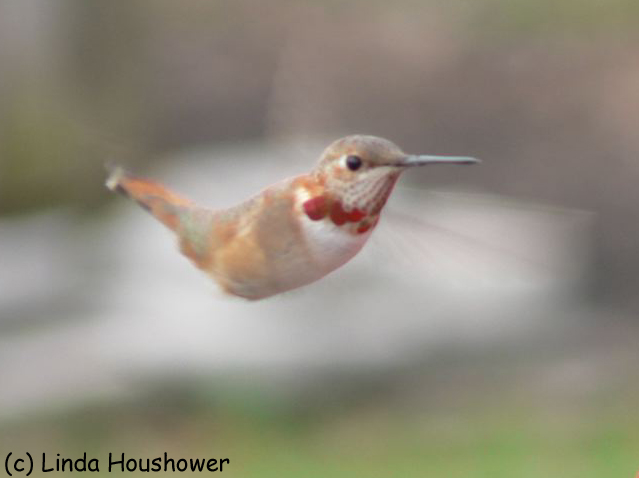 |
||||||||||
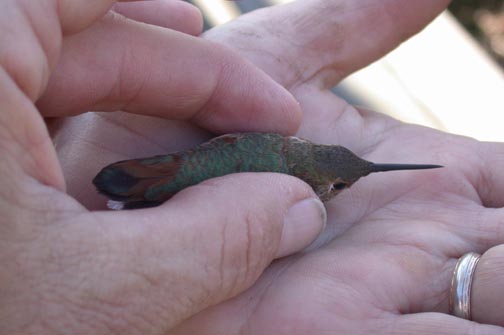 |
|||||||||||
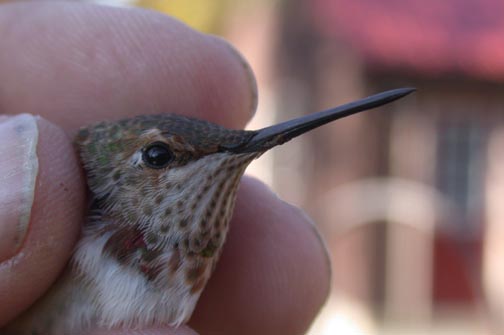 |
|||||||||||
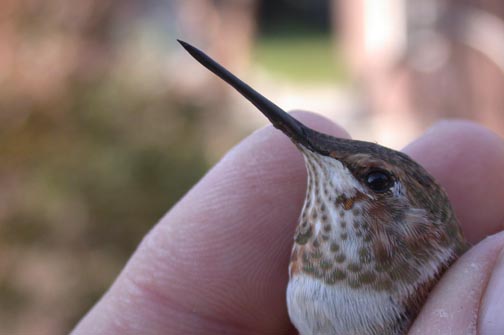 |
|||||||||||
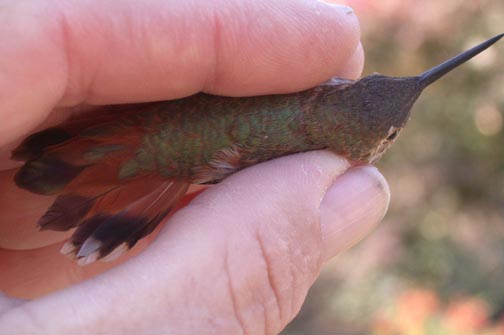 |
|||||||||||
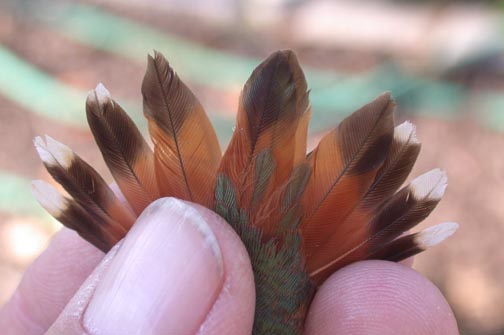 |
|||||||||||
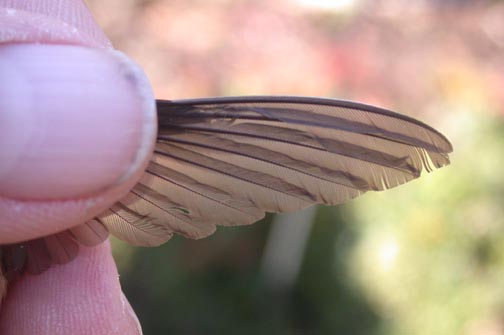 |
|||||||||||
